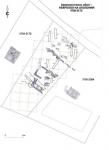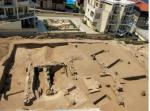Summary (English)
EXPLORATIONS IN APOLLONIA (Krastina Panaiotova – kpanayotova@abv.bg, Margarit Damyanov, Teodora Bogdanova) Twelve graves of the end of the 5th – middle of the 4th centuries BC were discovered. Nine burial pits were dug out into the bedrock. One burial pit was covered with stone slabs and, on its floor, there were holes to accommodate the legs of a funerary kline or sarcophagus. Three graves were constructed with ashlars and their floors were paved with stone slabs. A limestone quarry with cut outs for taking ashlars was discovered close to the necropolis. The deceased were laid supine with their heads mostly to the east. Only one burial of a child is without grave goods. The grave goods in the rest burials included lekythoi, an alabastron, an amphoriskos, jugs, cups, a bronze mirror, bronze tweezers and a bronze finger-ring. Grave No. 12 was a cenotaph. The burials were grouped in family sectors located from both sides of Via sacra which was 9 m wide. A funerary stele with partly preserved inscription in two lines: ...ΙΚΑΓΟΡΗΣ ...ΓΡΑΟΣΟ was reused in the enclosure of ritual hearth No. 1. Four family sectors in the necropolis were documented from the northeastern side of Via sacra and they had periboloi towards the road constructed of small ashlars and/or roughly-cut stones. Five ritual hearths were explored from the outer sides of the periboloi. The finds included dishes, terracotta fish grills, ichthyai, lekanai, askoi and animal bones. A midden pit was discovered, containing pottery, charcoal, shells, a terracotta figurine, bronze coins of Apollonia, arrowheads, fish hooks, nails, a loom weight and iron reaping hooks. To the southwest of Via sacra 281 bronze coins were found, most of them minted in Apollonia in the 4th century BC and some coins of Histria, Prokonesos and Antigonus II Gonatas. A hoard of 17 bronze coins (10 of them minted in Apollonia in the 4th century BC) was discovered from the outer side of Construction No. 3. A second hoard of 225 coins was discovered close to the northwestern side of Construction No. 3: 153 dichalkoi and 72 coins with large nominal value, some of them with the names of magistrates: EYКYΔHΣ, MYΣ, АКОYΣIΛ and IΩГYPOΣ.
- Krastina Panaiotova - Archaeological Institute with Museum
- Margarit Damyanov - Archaeological Institute with Museum
- Teodora Bogdanova - Archaeological Museum in Sozopol
Director
Team
Research Body
- Archaeological Institute with Museum
- Archaeological Museum in Sozopol






![Download [PDF]](/excavation/skins/fasti/images/results/download_sml.png)

